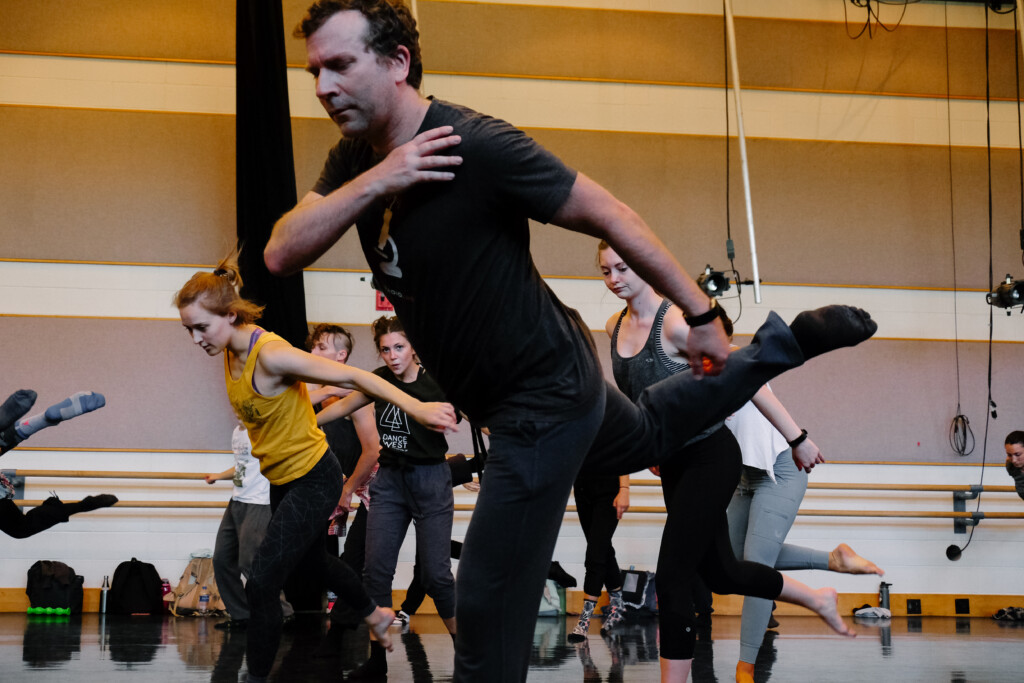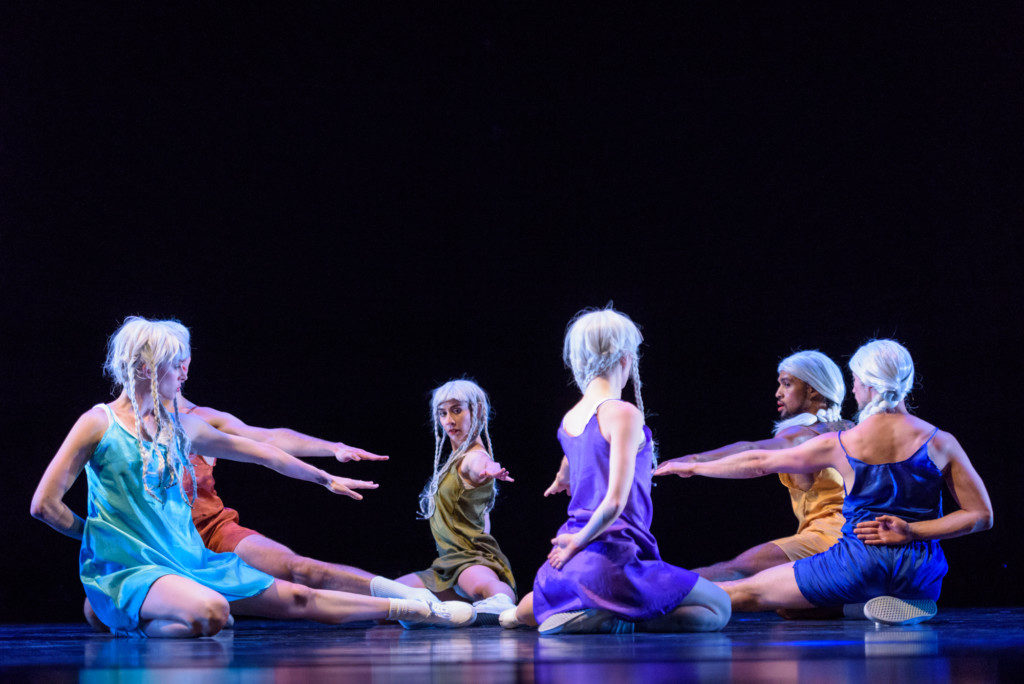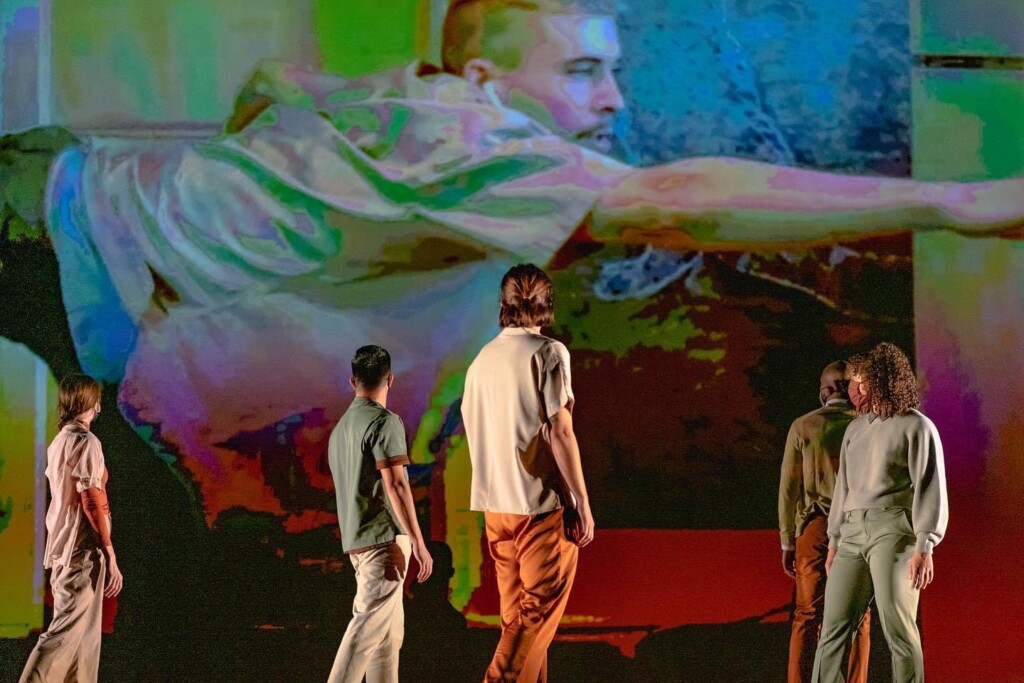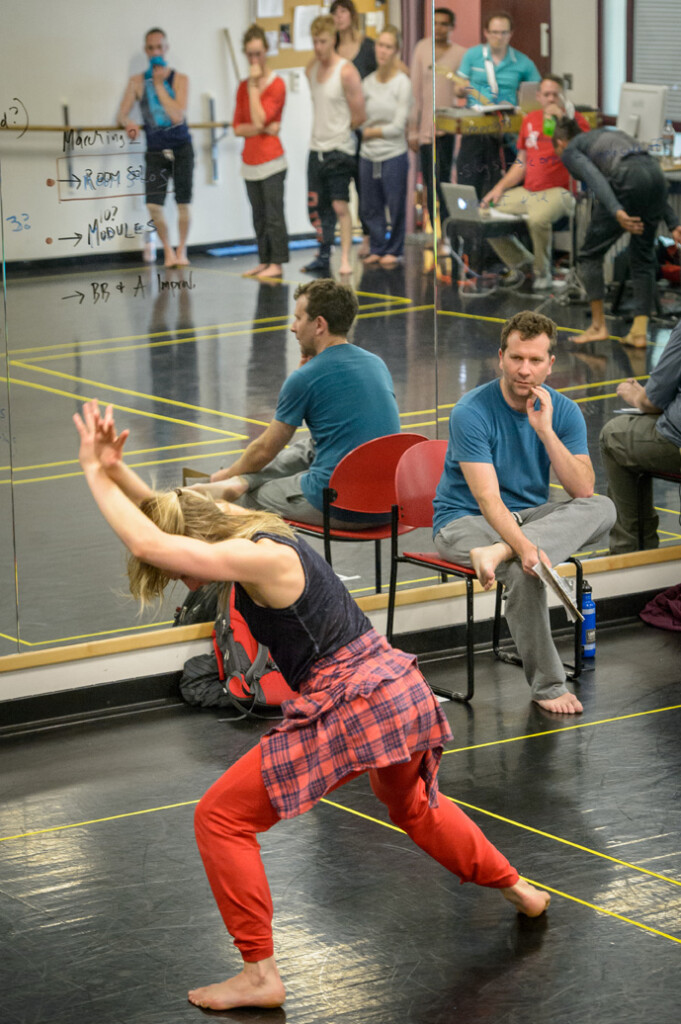EDITOR’S NOTE: Daniel Charon, artistic director of Ririe-Woodbury Dance Company, has announced that he will step down at the end of his 12th season in the spring of 2025. This feature encompasses interviews with Charon and Thom Dancy, executive director, as well as an overview of Charon’s work over the last 12 years.
In the arts as in any industry or business of historical importance and longevity, the most effective leader is a steward who tempers ego with humility in committing to the high standards that have forged the relationship with the community. In the Ririe-Woodbury Dance Company, more than 60 years ago, founders Shirley Ririe and Joan Woodbury laid the two essential cornerstones for high performance standards and omnipresent community orientation. When the founders eventually stepped aside to make way for a new generation of leaders, the ideal of steward leadership became paramount.
Twelve years ago, when Daniel Charon arrived in Salt Lake City as Ririe-Woodbury’s artistic director, the internationally known dance institution was marking its golden anniversary. His presence has magnified Ririe-Woodbury’s distinguished reputation. During Charon’s tenure to date, the company has presented more than 20 original dance works by him, as well as pieces from more than 50 guest artists from Utah, the U.S. and many places around the world.
Transitions and bridges are as important in a leadership culture as they are in creating a cohesive work of choreography. Sensitive to timing his decision to step down at the end of the season next spring, Charon says it came from a process that involved “listening to my mind and my heart. I didn’t have a specific moment in mind that made the decision.” During his tenure, Charon has consistently supported the decisions of dancers who have moved on after their experience with the company. In the arts, many artists are astute about the moment when they are ready to take a breath and contemplate the next phase of their life on and off stage, in the studio and in the broader realm of creative expression, either as an artist, performer or teacher.
There have been three artistic directors for Ririe-Woodbury since the turn of the millennium and the tenure of Charon, who succeeded Charlotte Boye-Christensen 12 years ago, comprises a full one-fifth of the company’s history.
Trust and respect: The synergy of artistic director and executive director
From an organizational perspective, it is not just the company’s numerous hallmarks of artistic excellence that have marked Charon’s tenure (which are summarized later in this article) but something equally as, if not more, important. That is the trust which Charon has established not only with the board members of Ririe-Woodbury but especially with the two executive directors during his tenure. In two extensive interviews with The Utah Review, it was always evident that both Thom Dancy, the current executive director, and Charon have established a level of trust as part of a mutually deep and respectful relationship.
Dancy, who succeeded Jena Woodbury as executive director in 2023, says that Charon made his first year “incredibly comfortable,” as he settled into his new position. Dancy has asked Charon to serve as consultant during the forthcoming transition. Both Dancy and Charon describe their ongoing conversations as “exceptionally thoughtful.”
Dancy and Charon acknowledge that the process for selecting the company’s next artistic director is about setting the base for writing Ririe-Woodbury’s next chapter, which will continue to honor the entrepreneurial artistic vision that the founders cultivated when they set forth their new age of contemporary dance. “Joan [Woodbury] and Shirley [Ririe] set an incredible work ethic and together they knew how to solve any problem for x and get the job done,” Dancy says. Charon adds that sense of work ethic was evident through the organization and dancers when he joined the company. “It was serendipity in how everything aligned so well, as I realized how much greater the organization was than just one individual,” he says.
In separate comments, Dancy and Charon talked about the symmetrical respect each have for the other’s role. This is an essential element in a healthy functioning arts organization but one perhaps that some outsiders or casual observers do not immediately recognize or appreciate. In some instances when an artistic director steps down, people assume and spread rumors about creative differences, which often are more erroneous than not. In the interviews with The Utah Review, it was immediately apparent that the two respective leaders are fully harmonized in their beliefs which befit the longevity and historical success of a pioneering institution in contemporary dance.
Indeed, as the company celebrated its 60th anniversary last season, it was the first time that Ririe-Woodbury was without a family member of either founder in a leadership role. Jena Woodbury stepped down as executive director, at the end of the 2022-23 season. Last November, cofounder Joan Woodbury died at the age of 96. Shirley Ririe is in her mid-nineties and has emeritus status.
The time for transition and bridge
Charon believes the moment has arrived to make that bridge. “There are entirely different faces here now than when I started,” he says. In the global network of dance, the degrees of separation are narrower than what a casual observer might notice. Charon previously danced in choreographer Doug Varone’s company for 10 years. Varone’s relationship to Ririe-Woodbury has spanned more than 30 years, starting with Smashed Landscapes, a work commissioned by the company’s founders, Shirley Ririe and Joan Woodbury. Charon says that being artistic director for Ririe-Woodbury has been an opportunity that at one time he never would have imagined experiencing. “It was such a good fit,” he adds, acknowledging how hugely grateful he was to Jena Woodbury for giving him the opportunity 12 years ago.
Charon has witnessed every major transition within the organization during his 12 years, as the focus has shifted from the founders to caretakers who are sensitive to the institution’s distinguished legacy. Dancy and Charon also have talked about being mindful of the community during such transitions.
It has been an exciting period under Charon’s artistic leadership. Visiting choreographers have included some of dance’s most widely known rising stars: Netta Yerushalmy, Joanna Kotze, Raja Feather Kelly, Keerati Jinakunwiphat, Culture Mill (Clint Lutes, Murielle Elizéon and Tommy Noonani) and Yin Yue. Ririe-Woodbury also has generously opened its creative spaces to local artists, including LajaMartin, Ann Carlson, Molly Heller, Stephen Koester and Michael Wall, among others. Dancers from area universities have periodically joined the company productions. For the recent 61st season opener, no one could have asked for a better nightcap than with Monica Bill Barnes’ It’s Great to Be Here, which brought the audience to its feet for a standing ovation. The work by the New York City based choreographer, whom Charon has known for many years, featured not only the six Ririe-Woodbury dancers but also 28 student dancers from six Utah universities: Utah Valley University, Brigham Young University, Weber State University, Southern Utah University, University of Utah and Westminster University.
Collaborative vigor
Charon also collaborated with the Salt Lake Electric Ensemble to create two evening-length works and a shorter one, which have included variously live performances, recorded original music and the ensemble’s internationally acclaimed interpretation of Terry Riley’s minimalist masterpiece In C. One work, created for family audiences, brought in Dallas Graham of the Red Fred Project and the Flying Bobcat Theatrical Laboratory. In 2023, Charon and the dancers set an evening length work of dance theater, in collaboration with stage director Alexandra Harbold, about the community will to save the Great Salt Lake. During the pandemic, with live performances grounded for many months, the company produced filmed concerts, including one with Repertory Dance Theatre. Prior to the 55th season, the company traveled to South Korea and Mongolia as cultural ambassadors, part of DanceMotion USA℠’s cultural diplomacy program, which was coordinated with the U.S. Department of State’s Bureau of Educational and Cultural Affairs and administered by The Brooklyn Academy of Music (BAM). Ririe-Woodbury was one of three American dance companies selected for the program.
Trust and spontaneity are keywords in Charon’s artistic process. “It has been a satisfying joy to generate so much work during the last nine to ten years [at that time], especially with dancers who support each other, have exceptional character and work ethic,” Charon said in a 2022 interview with The Utah Review. Perhaps, one of the best examples of why stewards succeed is how they see unforeseen events, challenges or new opportunities which test their resilience and preservation of legacy. This explains why Ririe-Woodbury was sustained through the prolonged COVID-19 pandemic shutdown. During that time, auditions for new dancers were held via Zoom and filmed concerts were streamed on demand, which included new works.
There is no doubt that the company’s collaborative vigor was vital in ensuring Ririe-Woodbury’s sustainability would not be obscured during the COVID-19 pandemic, an event that did not fit the box for a crisis that arts leaders and managers would have anticipated. The administrative and artistic domains converged perfectly, as Charon and the dancers created work that was filmed (including a production with Repertory Dance Theatre) and the small full-time staff led by the executive director (then Jena Woodbury) ensured that everyone’s well-being was prioritized during the long shutdown. New work was created during that period, including Autumn Sun, which came to fruition as Charon realized the challenge of “doing it very fast and getting it done.” Autumn Sun incorporated video design, enhancing an opportunity to simulate convincingly the representation of the “body’s deepest circuitry of total sensuousness,” a phrase The Utah Review had used to characterize Ririe-Woodbury’s 2017 performance of Kate Weare’s mesmerizing Unstruck, a composition choreographed for a trio. The video design element in Autumn Sun resolved a critical problem: then dance artist Nicholas Jurica was in quarantine because his wife had tested positive for COVID-19. For his duet with Dominica Greene, Jurica had his performance recorded via Skype during the production filming and projected onto the scrim, while Greene performed on stage. And, as with the other duets in the 18-minute piece, the effects demonstrated how the medium of film could be manipulated effectively.
During that pandemic season, Charon experimented with film again. A bona fide dance festival documentary, the Home Run concert gave Charon, whose master’s degree combined choreography and integrated media, the opportunity to take sole command of the process from conception to the filming and editing of a work featured in the film. In addition, Charon, who recently has taken up playing the violin for the first time since his younger years, set the musical score drawing from pieces he wrote in the mid-2000s but which never had been attached to a specific choreographed composition. Focused on capturing a seamless steadicam effect where one performer passes off to another, Charon said, at the time, that he wanted to recreate the energy of the walk-and-talk “cold opens” of the popular West Wing television series. With a hand-held gimbal, he captured the dancers in many spaces including the contemporary arts gallery at The Monarch studio, arts and entertainment complex in downtown Ogden.
The choreographer as facilitator
Diligent about the importance of collaboration, Charon has seen his role in the studio as a facilitator, encouraging the dancers to participate in the creative assignment and suggest movement phrases, gestures and even bits for a theatrical movement as needed. More frequently than not, Charon’s new works have been noted in printed programs as created in collaboration with the Ririe-Woodbury dancers. “On one level, I have learned not to be precious about the material I bring into the studio,” he says, adding that by acknowledging the facilitating dimension of being a choreographer, he does not feel it necessary to reinvent the process with every new work. “And, with dancers being a part of the process, I can have six versions of a movement phrase instead of just one,” he explains. In reviews published at The Utah Review, it is regularly noted how invested the six dancers are in these pieces, especially in moments where it is clear how the work has flexed seamlessly to telegraph the authentic personality of the dancers.
One compelling recent example was the 2023 premiere of the evening-length work gestation, To See Beyond Our Time, which was created with Alexandra Harbold of the Flying Bobcat Theatrical Laboratory. The work was envisioned as a potent third-way approach to engaging the audience to help build that critical mass of social will and consensus of opinion essential to addressing the existential crisis of the Great Salt Lake. Arts such as dance can stimulate the relevant conversation about the proper ways to mobilize efforts for saving the lake, without being burdened by pedantry, partisanship or moral lecturing. Over many months of its gestation, To See Beyond Our Time emerged from the union of diverse, deep pools of scientific expertise and informed advocacy and the dancers’ direct epiphanies, as they observed and articulated their thoughts by absorbing the choreographic and dramaturgical vantages involved in the process.

The opportunity for dancers to place their own imprint reinforced the core chemistry that has produced such gratifying kinetic energy in Ririe-Woodbury performances. Each dancer added their own text for To See Beyond Our Time. An outstanding example was Miche’ Smith’s exquisite reading of Where do the birds go now? The dancers’ eloquent contributions of text were interspersed with quoted prose by some of the best known names and authors in environmental conservation and preservation, including Terry Tempest Williams, Rebecca Solnit and Darren Parry.
For Dancy, it was evident early in his first year as executive director that there is no formalized hierarchy among Ririe-Woodbury dancers that one would find in, for example, a ballet company or in a larger dance institution. Consistently, first-year dancers at Ririe-Woodbury will have just as many moments as the most senior members for solo or duet opportunities. Just as significant is that even with a fairly active turnover rate of dancers in recent years, every season’s ensemble quickly finds their chemistry as a group completely comfortable with each other on the stage. The most recent example came last month in the premiere of Charon’s Purple Sonata 24, which also was the first regular season appearance for two new company dancers (Nick Elizondo and Luke Dakota Zender). The second movement in the work produced some of the finest touching moments, especially in the duet with first-year member Zender and Megan McCarthy, currently the company’s most senior dancer.
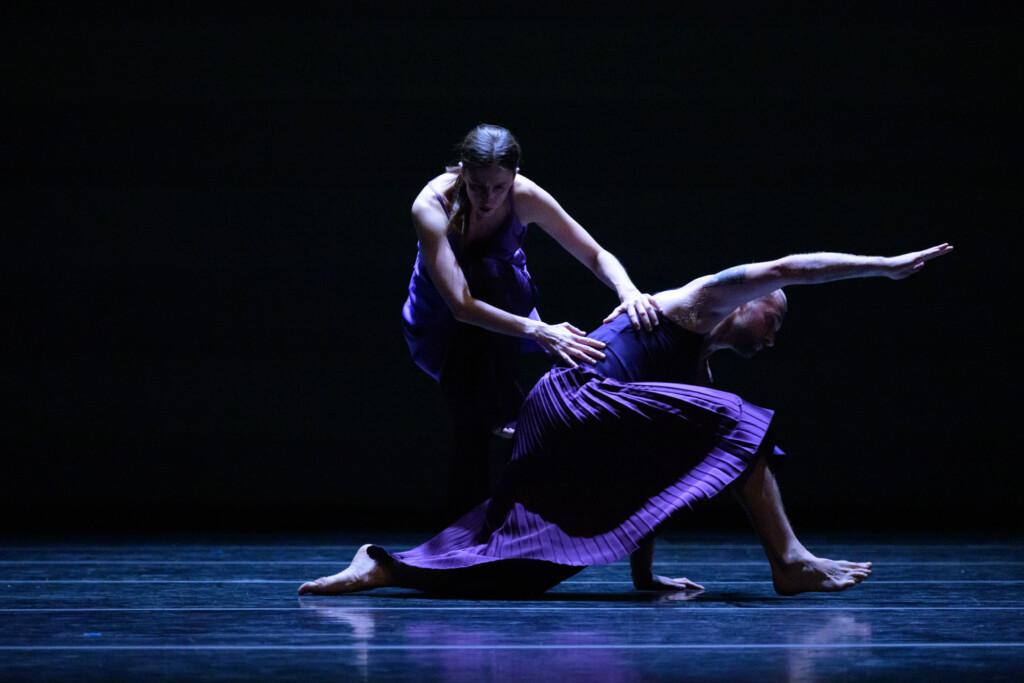
Photo: Stuart Ruckman.
What might surprise some is that the role Charon has considered most vital as artistic director is teaching company class. It is among the most important features in any dance institution, as a platform for mastering advanced technique, testing and experimenting with movement language and vocabularies and finessing ensemble chemistry and the kinetics of dance performance. Dancy adds that the company class, which is so specific to dance as one of the performing arts, is absolutely essential to maintaining the artistic character and culture of the dance institution. Likewise, honoring and maintaining Ririe-Woodbury’s prowess in educational programming, which Charon and his colleagues at the company have championed, is just as critical a factor in selecting the right steward to succeed Charon, Dancy explains. Utah is a leader in dance education, with the publicly funded Performance and Outreach Programs In the Schools (POPS), along with full-fledged dance programs at Utah public and private universities as well as dance teachers in the state’s high schools.
Charon’s choreographic catalog
The catalog of Charon works that have been added to the company’s repertoire is evidence of the sincere commitment to collaboration in the studio and on stage. In Charon’s second season, there was one of the boldest, most widely anticipated experiments of artistic collaboration in Salt Lake City up to that time. He set 53 Rooms, which incorporated 20 dancers on stage and a live performance of Terry Riley’s In C, a pioneering work of the minimalist music period, by the Salt Lake Electric Ensemble (SLEE). “For those of us who have been so heavily focused in music and uneducated or underexposed to dance, it has been fascinating to tap into the energy of how the dancers respond to Riley’s music,” Oliver Lewis, then a SLEE member, said at the time in an interview with The Utah Review.

Charon also premiered Shift, the first installment of a trilogy — Together Alone, which used dance to explore the sociocultural phenomenon of the virtual self in the age of social media. In sum, the trilogy examined the challenges of overcoming loneliness and false sensations of narcissism and connection in order to find a refreshingly sincere psychological community along with emotional support and intelligence. In the first installment, Charon’s choreography replicated with convincing effect the scientific and technological concepts he had in mind, such as duets representing the binary code strings of 0s and 1s as well as the double helix of DNA. “It then opens the door to locate our consciousness – are we still out there,” he explained in an earlier interview.
The trilogy also reflected, in part, Charon’s love of science fiction. For the second part, Enter, he worked with local composer Michael Wall, who has provided an encyclopedic catalog of music, samples, mixes and other sound design elements to choreographers and dancers. Charon described the second part as exploring the “multiplicity of ourselves – anonymous, real and imagined – through the avatars and profiles we use to define our existence in digital space and digital realities.” Enter, he added, then sets the context of how perhaps we can overcome the dread of depression or loss and use our solitude to contemplate and rediscover ways of making meaningful relationships in the digital age without necessarily disconnecting our digital selves.

Completing the trilogy, Return was a new realm of dance theater, which imagined the six dancers aboard a starship on a galactic journey, one of the classic elements of science fiction literature. Charon again turned to the Salt Lake Electric Ensemble, to produce an original soundtrack. In Return, the dancers speak text in several instances, including original dialogue by Robert Tennant, Google Artificial Intelligence and brief quotes from Kim Stanley Robinson’s science fiction novel Aurora (Orbit, 2015). Some of the dialogue scripted for the dancers was spoken in Spanish.
Charon’s work is multidisciplinary in its holistic and integrated forms. Return, which takes just a little more than an hour, absorbs the audience. At times, the dancers convey restlessness in their isolated environment, building the tension of wondering how they will ever liberate themselves from a space that is so restricted and their capacity for fully human interactions is even prohibited. The surprising thing about the spoken text up until the last short soliloquy is its mundane futility but then the final words uttered by one of the dancers clinch the redeeming effect. The passionate warmth of dance comes through – the opportunity to soothe the flattening pain of our digital and technological environment with the earnest appeal for loving interaction.
His love of literature has sparked unique choreographic compositions. Dance for a Liminal Space’s most intriguing element was its presentation. It was set in two sections but each with different music (contemporary composers Meredith Monk and Michael Gordon) and costumes (designed by dance artist and former company member Melissa Younker). The first segment was presented before intermission and the second following the break. Indeed, the break enhanced how the audience reflects upon the first segment and connects it to the second section. “The first part is introspective and isolating, as it comes from a dark space in one’s consciousness,” Charon said in a previous interview with The Utah Review, “while the second signifies that time has passed and expresses how one filters through their memories and perhaps even return to something they had forgotten about.” In 2020, just before the pandemic, Aberrations of Light premiered. Charon built the piece from a line in the 1994 book Pale Blue Dot: A Vision of the Human Future in Space by Carl Sagan: “No longer confined to a single world, we are now able to reach out to others and determine decisively what kind of planetary system we inhabit.”
Charon has periodically set work responding to other contemporary events, including the aforementioned To See Beyond Our Time. One was Elegy, created in memory of the victims killed during the 2016 mass shooting at the Pulse nightclub in Orlando. Suggesting a ghost-like memory, the work was choreographed to music by Bach.
Among the most exuberant pieces Charon created for Ririe-Woodbury dancers was Exilic Dances, which he said was “a work about family and community, and embracing and welcoming a stranger.” Once again displaying his astute grasp on pop culture he added, “It’s like musical theater: Fiddler on The Roof meets Chicago meets South Park.” Indeed, Exilic Dances, a suite of eight pieces with music by Klezmer Juice and Golem, was an exhilarating tour de force of dance musical theater. It emerged as a refreshing tonic, a celebration of ancestral roots, cultural pride and newfound respect for a country that translates effectively to any immigrant tradition. Klezmer music’s essentially global character propelled the boisterous and humorous feel of Charon’s choreography, executed with infectious charm by the company’s dancers who also did not miss a beat working with and clearing the numerous props incorporated into the performance.
To open the company’s 58th season and the return to live performances for the first time in 20 months, Charon set On Being, a work of pure natural energy that introduced audiences to the company’s six dance artists, including five of whom either were then in their first or in their second season. The work elicited distinctive personality traits of the artists and the dancers visibly were delighted as they did artistic justice to an elegantly choreographed statement on the theme of solace. There were moments of remembrance but also joy in the return to unrestrained movement, where partnering once again seemed natural. On Being offered a well-earned respite from the emotionally taxing prolonged period that all of us endured since the early spring of 2020. Meanwhile, to close the same season, Charon set The Break of Day, a starburst of choreographic joy with a rhythmic language that popped perfectly with the music of The Chairman Dances: Foxtrot for Orchestra by composer John Adams, a musician who has been a particular favorite of numerous choreographers.
Epiphanies and reflections
In 2018, after the company returned from its Asia tour, Charon reflected on its impact, which confirmed for him that “we really don’t need to change the wheel.” But, he added in that same interview, that it also enlivened and strengthened everyone’s sensibilities and sensitivities about making the connection to different audiences and demonstrating how dance for everyone can be anything and everything but intimidating and discriminating based on ability or experience. This became the seed for the company’s Moving Parts Family and Sensory Friendly matinee series, which continues to this day.
If there was one Charon piece that epitomIzes his appreciation for the artistic epiphanies of transitions and bridges, it is Everything That Changes, a work he set during his first year as the company artistic director and which coincided with Ririe-Woodbury’s 50th anniversary season then. In 2022, he returned to the work on the occasion of his tenth anniversary with the company. Considering the efforts a dance company endured in coming out of the pandemic and with an ensemble that has been remade in its near entirety over the previous two seasons at the time, this piece and its latest performance renewed its original thematic message. It is an ebullient composition of perpetual motion, reminding us of the resilience that Ririe-Woodbury has enjoyed for more than six decades.
For the 60th anniversary season, Charon created Storyograph which was the third collaboration Charon had with the internationally known Salt Lake Electric Ensemble. The group’s six members performed on stage behind the dancers, offering an original electro-acoustic score, featuring laptops, keyboards, a minimal drum kit, electric cello and electric guitars. Storyograph is very much like a choreographic variation of Luigi Pirandello’s Six Characters in Search of an Author, a play from the 1920s. In the play, the characters announce that their original author has not fully completed them so they are now searching for another author to finish the task. Something similar happens in Storyograph, which amplifies the values of identity and relative truths. The dancers engage movement individually and in various partnering combos to discover that no individual is ever complete until they realize that their own existence depends upon acknowledging the essential importance of shared community ideals, perspectives and a willingness to work together and find consensus. It was a philosophical testament to the beauty and genius of the vision that has sustained the company ever since Ririe and Woodbury established the historic performing arts institution.
Charon has been astute and unfailingly sensitive to the unique character of the Ririe-Woodbury soul that its founders nurtured and took meticulous care of during their long tenure, a point that Dancy also emphasized in both recent interviews with The Utah Review.
Charon’s decision to step down at the end of this season and the commendable synergy that he and Dancy have established amplify that Ririe-Woodbury’s success has always depended on the intangible assets of trust, good decision-making, artistic and managerial expertise, reputation and relationships, intellectual capital, a positive organizational culture and the quality of the artistic and administrative members. This is why on and off stage, Ririe-Woodbury consistently performs at a level of excellence, acknowledged and respected in the international dance community. Dancy and Charon are committed to ensuring the leadership transition honors this legacy, by maintaining its strong bonds with the dance community and the larger Utah public while instilling new projects that refresh and expand the enterprising realm of creativity that has always been at the core of Ririe-Woodbury.


